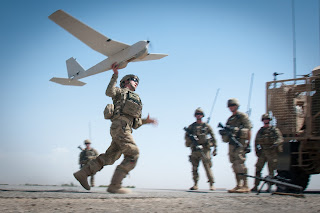Russia recently developed the Kasatka drone, a multifunctional system primarily for military purposes. Russia officially introduced the Kasatka, also known as the “Killer Whale,” in January 2025. It is capable of performing a variety of functions, such as offensive operations, reconnaissance, and signal relay. Aerofregat, a company located in Novosibirsk, was responsible for the development of the Kasatka drone.
Operating at altitudes of one to two kilometers, the Kasatka’s primary function is to transmit direct radio commands over a range of up to 50 kilometers while relaying radio signals. This capability enables it to regulate other drones, including Tribunal drones, which are kamikaze quadcopters.
The drone is capable of operating as a kamikaze UAV by transporting a payload of up to 3 kilograms of explosives. It can remain airborne for an estimated 40 minutes to one hour and has an operational range of 70 kilometers in this configuration. In addition, the Kasatka is equipped with reflectors that replicate the radar signatures of larger drones, such as the Geran or Orion. This capability enables it to serve as a decoy, thereby diverting adversary air defenses from more valuable assets.
The Kulibin Club of the People’s Front, which is dedicated to the promotion of domestic engineering projects for military purposes, is a supporter of the initiative. By implementing innovative technologies and strategies that address the challenges of modern warfare, this collaboration aims to enhance Russia’s military capabilities. The introduction of the Kasatka drone exemplifies modern military strategies that prioritize cost-effective solutions in warfare and incorporate advanced technology for offensive operations and reconnaissance.
 |
| TraMP |
Russia has introduced a number of drones that are specifically designed for military applications, including logistics and reconnaissance, in addition to the Kasatka drone that was recently developed. TraMP (Transport Aviation Multipurpose Platform), which is colloquially known as the “Trump” UAV, is one such example. This tactical transport drone is capable of transporting cargo weighing up to 250 kilograms over distances exceeding 600 kilometers. Its purpose is to streamline logistical operations and enhance operational flexibility in challenging environments by acting as a communications repeater. The Trump UAV is presently in the process of being tested, and its inaugural flight is scheduled for April 2025.
 |
| Knyaz Vandal of Novgorod |
The Knyaz Vandal of Novgorod (KVN) drone, which has been operational since 2024, is another noteworthy advancement in Russia’s drone arsenal. This drone is capable of transporting 3.5 kilograms of explosives and has a range of approximately 20 kilometers. It is resistant to electronic interference due to the presence of a fiber optic cable that enables high-resolution imagery and precise precision strikes. The KVN drone’s design resembles certain Chinese models, suggesting that foreign entities may have influenced it.
 |
| Piranha-5 drone |
Furthermore, Russia employs the Piranha-5 drone, which provides infantry operations with a payload of 1 kilogram over a radius of 1 to 3 kilometers. Direct support to ground forces is provided by these drones, which improve battlefield capabilities.
Additionally, the integration of advanced AI systems has improved the autonomous targeting capabilities and resilience against electronic warfare measures of Russia’s Shahed drones.
Ukraine has created the Vidlunnia, an aerial repeater that is intended to increase the communication distance between the drone operator’s control console and the drone. The Vidlunnia, mounted on a DJI drone, guarantees a consistent connection, even in contested environments, thereby enhancing operational effectiveness.
 |
| Vidlunnia aerial repeater on DJI Drone |
The United States, NATO, and China have also developed a variety of repeater drones in comparison to other nations. The United States has prioritized the development of drone technology for military applications, which includes the utilization of drones such as the RQ-20 Puma and RQ-11 Raven. These drones are capable of functioning as communication relays in addition to their reconnaissance capabilities.
 |
| RQ-20 Puma |
The European component of NATO has developed and deployed various repeater drones to enhance operational capabilities and communication among its member states. One notable example is the Wingman drone detection solution, which was developed by MyDefence in Denmark. Although it is primarily intended for drone detection, it can be integrated with other systems to serve as a communication relay, thereby improving operational coordination and situational awareness among NATO forces.
 |
| Wingman drone detection solution, MyDefence |
Another example is the MAUS drone, which debuted at the ILA 2024 fair. This quadcopter is modular and can be configured for a variety of missions, such as operating as a loitering munition and potentially as a communication repeater. Its design prioritizes user-friendliness, rendering it accessible to operators with minimal instruction.
 |
| MAUS drone |
NATO has been investigating a variety of counter-unmanned aerial systems (C-UAS) that may possess communication relay capabilities in addition to these. NATO’s emphasis on these technologies demonstrates its dedication to confronting the evolving threats posed by small drones in contemporary warfare.
China has also made substantial progress in drone technology, as evidenced by the Wing Loong II, which is capable of incorporating communication relay capabilities. These drones, designed for both surveillance and assault missions, can support extended operational ranges by relaying signals.
 |
| Wing Loong II |
In general, the strategic emphasis on improving operational effectiveness and communication in contemporary warfare is evident in the development of repeater drones in these nations.
Official Website of Youtube Channel – Altitude Addicts

